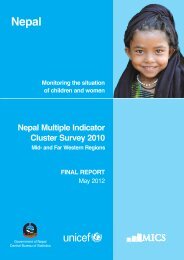Chapter 15 Internal Migration in Nepal - Central Bureau of Statistics
Chapter 15 Internal Migration in Nepal - Central Bureau of Statistics
Chapter 15 Internal Migration in Nepal - Central Bureau of Statistics
You also want an ePaper? Increase the reach of your titles
YUMPU automatically turns print PDFs into web optimized ePapers that Google loves.
Female<br />
Male<br />
Female<br />
Male<br />
There is a significant difference between the pyramid <strong>of</strong> the total population and those <strong>of</strong> migrants<br />
and non-migrants. There is also a significant difference between the age and sex composition <strong>of</strong><br />
migrants and non-migrants. The pyramid <strong>of</strong> non-migrants is broad based like that <strong>of</strong> the total<br />
population and it tapers upward but with a cap <strong>of</strong> 65+ years. The pyramid <strong>of</strong> migrants is narrowbased.<br />
As expected, migrants are positively selected <strong>in</strong> term <strong>of</strong> both age and sex. Especially 20-34<br />
years age group dom<strong>in</strong>ates among migrants with dom<strong>in</strong>ation <strong>of</strong> males. Surpris<strong>in</strong>gly a proportion<br />
<strong>of</strong> 65+ age group looks similar to the age group 45-49 years. More economically active<br />
population, higher proportion <strong>of</strong> elderly (mostly retired) and narrow base <strong>of</strong> the pyramid among<br />
migrants are quite contrast<strong>in</strong>g to the age and sex composition <strong>of</strong> non-migrants. Further analysis is<br />
needed to exam<strong>in</strong>e <strong>in</strong> detail the regional and district level variation <strong>in</strong> the population pyramid.<br />
However, the present picture <strong>of</strong> the age and sex composition <strong>of</strong> migrants shows that still there is a<br />
high demand for primary and secondary level schools <strong>in</strong> the rural areas <strong>of</strong> orig<strong>in</strong> <strong>of</strong> migrants.<br />
<strong>Nepal</strong> has been experienc<strong>in</strong>g <strong>in</strong>creas<strong>in</strong>g volume <strong>of</strong> <strong>in</strong>ternal migration after the control <strong>of</strong> endemic<br />
malaria <strong>in</strong> the Tarai (Pla<strong>in</strong>) and Inner Tarai Valleys s<strong>in</strong>ce the early 1950s. Table <strong>15</strong>.5 provides the<br />
volume and percentage <strong>of</strong> native-born, foreign born and <strong>in</strong>ter-district and <strong>in</strong>ter -regional migration<br />
from 1961 to 2001. From 1961 onward, the absolute volume <strong>of</strong> <strong>in</strong>ter-district migration <strong>in</strong>creased<br />
by 7 times dur<strong>in</strong>g the last 40 years and that <strong>of</strong> <strong>in</strong>ter -regional migration volume <strong>in</strong>creased by 4<br />
times s<strong>in</strong>ce 1971. Despite broad base <strong>of</strong> native born population, the percentage <strong>in</strong>crease <strong>in</strong> both<br />
<strong>in</strong>ter-district and <strong>in</strong>ter-regional migration has been substantial.<br />
131
















